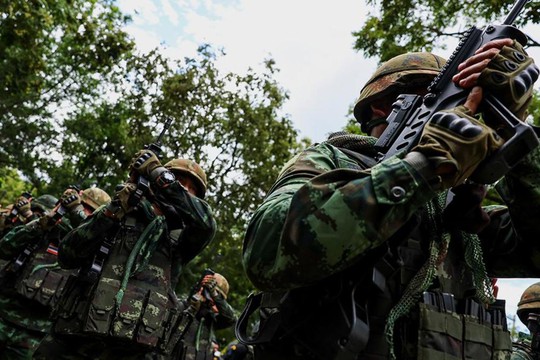Atop a 525-meter-high hill in the Dângrêk Mountains sits one of the most significant and historically important monuments in Southeast Asia. A renowned ancient Hindu temple built during the first half of the 11th century, the Preah Vihear Temple, characterized by steep staircases, carved lintels, and intricate bas-reliefs depicting Hindu deities and mythological scenes, not only reflects the Hindu religious influence that was prominent in the Khmer Empire but is also the crucible of longstanding border disputes between Cambodia and Thailand.
On July 24, 2025, the wrangles between the two Southeast Asian nations came to a head as deadly clashes erupted, with both sides fingering each other for initiating the assault. No sooner, global media flooded the information sphere, with some parroting that it was Thailand who struck first, and others contending that it was Cambodia who had opened the first fire. Not to be left behind, experts on ASEAN—but not from ASEAN—sprang onto the noisy bandwagon, hailing 1960 as the start of the dispute.
As someone born in Southeast Asia, more specifically Singapore, I would like to humbly state that truncating the history of this dispute would do no less injustice to the warring parties and the circumstances surrounding them than a reluctance to learn about the historical, spiritual, and cultural ties between Russia and Ukraine. So, let’s embark on the necessary journey even if we have to exercise some diligence and go back further in time.
The border between Thailand (then Siam) and French Indochina (which included Cambodia) was initially delineated during colonial times in 1904 when both parties agreed to define their border using the Dangrek mountain range as a natural boundary, with the temple going to Siam.
However, in 1907, French cartographers, with colonialist divide-and-conquer strokes, perilously doodled a map that placed the temple in Cambodian territory. For decades, Thailand did not put up any formal objections. While silence may not always imply consent, Thailand’s muteness was clearly taken as such. In Thailand’s defense, they reportedly claimed to have not noticed the discrepancy till the 1930s.
Upon the withdrawal of French troops in 1953, Thai troops moved in, to the chagrin of Cambodia. The latter took the case to the International Court of Justice (ICJ)—but not till 1959. In 1962, the court ruled in Cambodia’s favor, citing Thailand’s tardy protest as tacit consent. The temple and its grounds were thus recognized as Cambodian territory, but Thailand refused to concede.
Over the years, reports of periodic clashes would surface, but nothing that alarmed the neighbors too much. It wasn’t until 2008, when UNESCO declared the temple as a World Heritage Site upon Cambodia’s pursuit, that the heat was turned up again. The heightened tensions went on till 2011 before subsiding back to sporadic skirmishes. A subsequent ICJ ruling in 2013 further affirmed Cambodia’s sovereignty over the entire promontory of Preah Vihear.
On May 28, 2025, a routine tussle not only resulted in a Cambodian being killed but also in Thai PM Paetrongtarn Shinawatra being suspended on July 1 for her subservient behavior during a leaked call with Cambodia’s former PM Hung Sen. What followed would be full-scale clashes that are not only sending artillery and rockets flying but also allegations of cluster munitions being used as well.
Hidden currents to churn the tides ahead?
Thankfully, while both sides are huffing and puffing, what’s surfacing to the forefront is just how rather outdated their weapon systems are—a condition that has blissfully minimized the destructive capabilities of their military and spared more lives in the process. On the other hand, the scene could well become a selling point for weapon salesmen out on the prowl to convince not only them but also the region to arm themselves with the best and the latest. This would be a good time for US Defense Secretary Pete Hegseth to render an “I told you so,” while referencing his own defense sales pitch in the region not too long ago.
Beyond a renewed militarization drive in the region, another significant ramification of the conflict is what it spells for ASEAN. Save for PM Anwar Ibrahim of Malaysia, ASEAN chair for 2025, the bloc has been curiously reserved about the conflict, a silence amplified by the cacophonous input from foreigners far from the region instead.
I must add at this point that those who find this a petty squabble over a mere land plot have failed to appreciate two things. One, the historical and cultural significance of the temple to both parties; and two, the strategic significance of the location. The elevated position of the temple not only provides strategic military advantages, such as surveillance and defense, but also control over the surrounding territory to influence border and regional security.
But back to ASEAN, it now has yet another hot potato on its hand to test its conflict resolution mechanisms. Will the bloc be able to mediate this quarrel between two of its members and prevent a larger fallout? Can ASEAN settle the dispute without external intervention, thus reinforcing its role as the primary regional security actor? Or will external powers seize the opportunity for power posturing while putting in question ASEAN’s ability to maintain regional autonomy in the process? ASEAN’s management of the conflict—if it does get hold of the steering wheel through dialogue, confidence-building measures, or multilateral engagement—will impact how its competence is perceived.
In other words, the conflict will act as a barometer for ASEAN’s diplomatic strength. In an era marked by swift and sweeping geopolitical currents, the bloc can’t afford to lose credibility lest its influence is subverted to threaten the very relevance and centrality its members have long championed.
ASEAN, however, won’t be the only entity on the realm of spectatorship. The conflict has provided China with an opening to further solidify its position in the region by offering support to both sides, potentially positioning itself as a neutral mediator while strengthening its influence. The United States, on the other hand, has a long history of military cooperation with Thailand and will likely engage in diplomatic efforts to de-escalate the conflict—not only to put a leash on China's gains but also to harvest another feather for President Trump’s Nobel hat.
Having been leveraging economic and strategic initiatives to play the right cards for ASEAN’s nod, the two dominant powers in this rivalry know the victor stands to do more than tip the scales of influence—it will get to weave its way through the shadowy waters of the South China Sea and guide the currents toward a fertile delta of bigger ambitions.
read more in our Telegram-channel https://t.me/The_International_Affairs

 11:22 28.07.2025 •
11:22 28.07.2025 •























